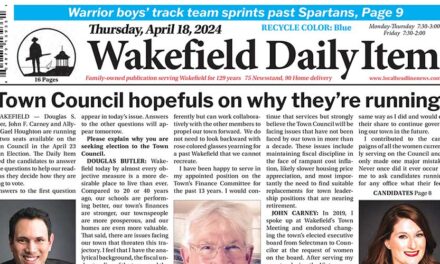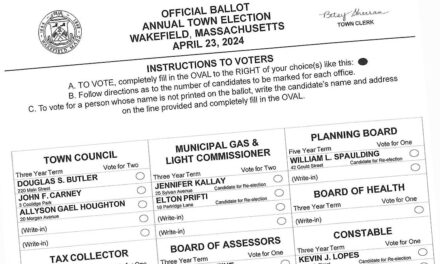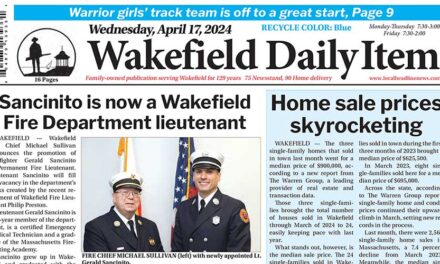Published in the August 4, 2016 edition.
WAKEFIELD — New data released by the state yesterday regarding opioid-related overdoses did not come a surprise to Catherine Dhingra, Wakefield’s Drug Abuse Prevention coordinator.
“Unfortunately the state data is not surprising since we are a part of District Attorney Ryan’s Eastern Opioid Task Force and have been watching the high rates of fatalities in 2016,” Dhingra said. “We also know that our EMS and other first responders in Wakefield and surrounding communities are utilizing Nalaxone (Narcan) at high rates, successfully reversing many overdoses. The increasingly high potency of the heroin and presence of fentanyl has unfortunately contributed to the fatalities.”
The Massachusetts Department of Public Health (DPH) yesterday released preliminary data for the first half of 2016 on opioid-related overdose deaths among Massachusetts residents. The data shows that fentanyl-related deaths in Massachusetts continue to rise. Sixty-six percent of 2016’s confirmed opioid-related overdose deaths had a toxicology screen that tested positive for fentanyl, an increase over 2015 (57 percent). The state began including data analysis on fentanyl and its disturbing relationship to opioid-related deaths in the first quarter of 2016.
“Collecting statewide data on fentanyl-related deaths will play a critical role as the Commonwealth works to bend the trends and combat the opioid crisis in our communities,” said Governor Charlie Baker. “While we have completed several reforms and passed landmark legislation, this deadly epidemic is still devastating too many Massachusetts families and treatment, education and prevention will remain a top priority for our administration.”
As the Baker-Polito Administration continues its efforts to fight the opioid epidemic through enhanced data reporting to support communities, policy makers and front-line clinicians, DPH analysts have partnered with the Office of the Chief Medical Examiner to report and analyze more up-to-date data than ever before; developed and implemented a predictive modeling approach to provide estimates of opioid overdose deaths and begun collecting, analyzing and reporting supporting data regarding fentanyl and naloxone use. The data released today indicate that:
· For the first six months of 2016, the opioid death rate is higher than the first six months of 2015.
· Data from the Prescription Drug Monitoring program shows that the total number of opioid Schedule II prescriptions, and the number of individuals receiving Schedule II prescriptions were both at their lowest level since at least Q1 2015.
· The rates of benzodiazepines and cocaine present in opioid deaths have been fairly steady since 2014, while the rates for heroin and prescription drugs have been decreasing at roughly the same rate that fentanyl has been increasing.
· In the first quarter of 2016, of the EMS services reporting their data to DPH, responses to opioid-related incidents were in 199 of the 351 Massachusetts cities and towns (57 percent). Overall, the number of opioid-related EMS transport incidents nearly doubled between 2013 and 2015 and 81 cities and towns also saw at least a doubling of events during this time period.
· On average, EMS administered Naloxone 1.4 times per opioid-related incident in the first quarter of 2016 indicating that more of the drug is needed to reverse overdoses.
“As this report details, the prevalence of fentanyl increases the lethality of overdoses,” said Secretary of Health and Human Services Marylou Sudders. “We continue to increase the number of treatment beds and are expanding the availability of all services from acute treatment to residential beds to medication assisted therapies.”
Earlier this month, 30 additional acute treatment beds opened at Taunton State Hospital, bringing the total number of dedicated Section 35 beds to 167 to treat women who are civilly committed. 64 acute and step down beds opened in Greenfield last month for the treatment of individuals who need medical monitoring. A total of 45 new and existing treatment beds specifically for males age 13-20 and females age 16-20 located in Western, Central and Southeastern Massachusetts and 30 transitional support services beds at Western Massachusetts Hospital are scheduled to open in the coming months.
In addition to increasing treatment, the Baker-Polito Administration is implementing a new Prescription Monitoring Program (PMP) online system later this month to improve performance, access and usability in the midst of the ongoing opioid crisis. The system will closely track the number of prescriptions being written and filled in an effort to reduce the number of pills on the street, in people’s homes and out of young people’s hands and to provide prescribers with greater analytic tools. The new online PMP system will include:
An improved user-friendly interface and faster access to reports;
Ability to communicate with other states’ online PMP systems, preventing duplicate prescribing between states;
Efficient onboarding for users including prescribers, delegates, residents and interns and pharmacies and dispensers.
“In order to address this crisis like the disease it is, we must continue to improve our ability to collect, analyze and act on data,” said Dr. Monica Bharel, commissioner of the Department of Public Health. “The improved Prescription Monitoring Program will enhance clinical decision making and our capacity for data analysis at a public health level.”
In June 2015, the Governor’s Opioid Working Group released recommendations and a comprehensive Action Plan aimed at curbing the opioid epidemic. These short and long-term recommendations focus on prevention, intervention, treatment and recovery support. Other Working Group initiatives completed or actively underway include:
· Successful cross-institutional, public/private agreement by the Commonwealth’s four medical schools and three dental schools, the Massachusetts Medical Society and the Massachusetts Dental Society in developing a first-in-the-nation set of core competencies to be taught by all of the medical and dental schools, ensuring best practices for prescription drug use and management are learned by all graduating students;
· To date, over 100 communities including first responders, high schools and colleges have purchased over 5,574 doses of Naloxone and 5,709 atomizers through the Bulk Purchasing program through the State Office of Pharmacy Services (SOPS);
· In January 2016, the Baker-Polito Administration distributed nearly $8M in federal and local grants to health care entities and municipalities to create programs to prevent addiction and arm themselves with life-saving naloxone;
· DPH started voluntary certification of sober homes in January for the first time in the Commonwealth. 63 sober homes voluntarily certified to date, representing over 812 beds.
Dhingra said that in Wakefield many community partners have made combatting the opioid epidemic a top priority.
“Wakefield Police, Action Ambulance, Melrose-Wakefield Hospital and Human Service agencies including Elliot, Riverside and South Bay are adapting their services and developing new programs to help people access recovery and maintain sobriety,” Dhingra said. “Here in Wakefield we currently have openings in our SOAR Program (Substance Abuse & Opioid Awareness & Reduction), a support group for young adults working toward and maintaining sobriety.”
Contact Catherine Dhingra, Wakefield Health Department, 339-219-4034, for more information on the SOAR Program.




